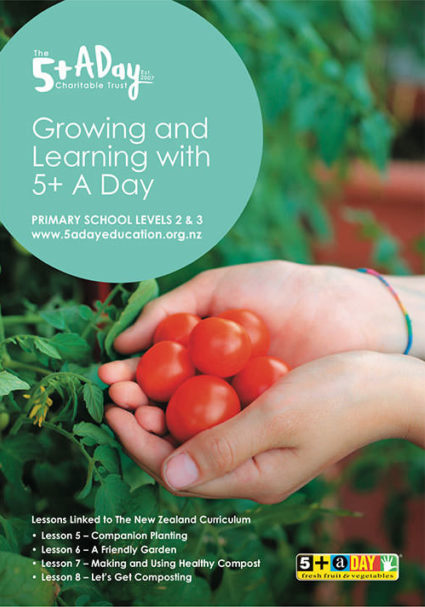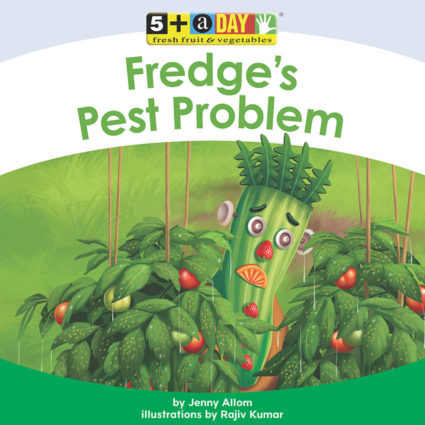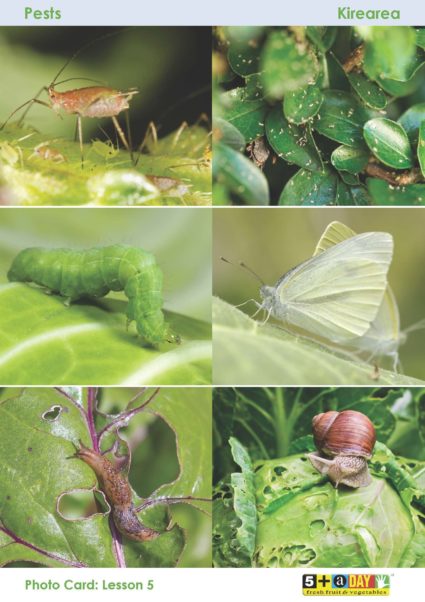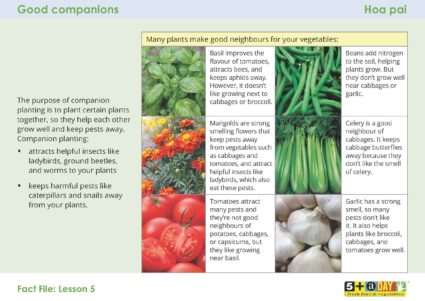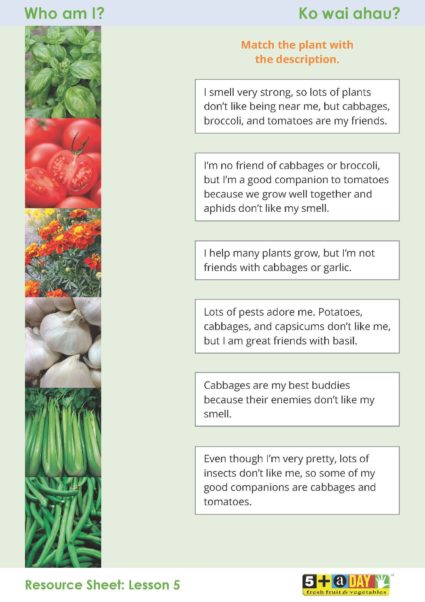Primary
Lesson 5: Companion Planting
In this lesson, students will explore the importance of companion planting when growing healthy fruit and vegetables. In the follow-on Lesson 6, students will design a garden and add companion plants to keep pests away.


This lesson is featured in our printed resource; Book 2: Growing and Learning with 5+ A Day, Levels 2 & 3.
Order the print version here or download here to print yourself.
Learning Intentions
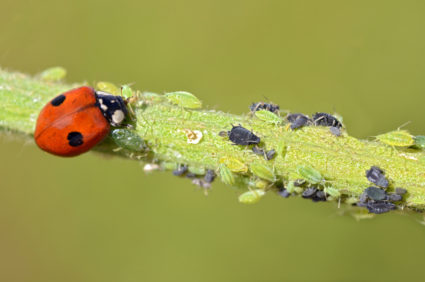
Students will:
- discuss the natural ways of preventing pests such as companion planting
- Identify plants that grow well together and plants to keep apart
- identify different insect pests.
Possible Achievement Objectives
Health and Physical Education: Level 2
SOCIETAL ATTITUDES AND VALUES
Students will:
- explore how people’s attitudes, values, and actions contribute to healthy physical and social environments.
Science: Level 2
ECOLOGY
Students will:
- explain how living things are suited to their particular habitat and how they respond to environmental changes, both natural and human induced.
PARTICIPATING AND CONTRIBUTING
Students will:
- use their growing science knowledge when considering issues of concern to them
- explore various aspects of an issue and make decisions about possible actions.
Preparation
What You Need
- eBook: Fredge’s Pest Problem
- Photo Card: Pests/Kireare
- Fact File: Good companions?/Hoa pai
- Resource Sheet: Who am I?/Ko wai ahau?
Additional Resources
- Working with Nature, Connected 2, 2010
- The Buzz of Bees, Connected 2, 2012
- "Garden with Science", How Do You Know? Connected 2, 2014
Key Vocabulary
These words are important to this lesson, and can be defined and explored in context as you discuss the topic with your students. A number of content words are provided in English and Māori. Introduce terms in both languages as appropriate.
nutrients/taiora: chemicals or minerals in the soil that plants take in through their roots and use as food
pests/kirearea: insects, bugs, or other animals that eat or damage the leaves, roots, or fruit of plants
sap/pia: the fluid that flows through a plant; like blood flows through a human body
Learning Opportunity
This lesson will introduce the students to the concept of companion planting and the identification of plants that grow well together and keep insect pests away, and the plants that don’t grow well together because they attract harmful insects. Students will also learn that companion planting is a good choice because it is a natural way of preventing pests.
The Lesson
eBook: Fredge’s Pest Problem
Begin the lesson by sharing the eBook, Fredge’s Pest Problem (click on the cover of the eBook). There is audio for this story that you can use, or students can take turns to read the text.
The eBook focuses on using companion planting when growing vegetables in order to prevent pests. For information on using 5+ A Day eBooks, click here.
There are two interactive activities that follow the eBook. They work on a computer, a tablet, or an IWB. They can be used during or at the end of the lesson or in choosing time to reinforce key information from the story. Students will get the most from these activities if you model them first and explain the actions required and the aims of the activity. Then students can do them independently or in pairs.
For Activity 5, help keep pests away from Fredge’s cabbages by dragging the correct companion plants into the garden. If you try to drag an incorrect plant into the garden, a butterfly will fly down to the garden. Drag the bird seeds into the bird feeder in the tree to attract the bird into the garden. For Activity 6, drag the helpful creatures into the garden.
Making a prediction
Read to the end of page 5, then ask the students to predict whether Liam’s idea of spraying the tomato plants with water will get rid of the aphids.
- What is Liam’s idea?/He aha te whakaaro o Liam?
Do you think it will work?/Ki ou whakaaro, ka hua?
Read on and stop at an appropriate point.
- Was your prediction correct? Did Liam’s idea work?
After you have shared the eBook, discuss the story and how Mrs Paku used companion planting.
- How does Mrs Paku keep pests away from her vegetable garden? (She uses companion plants.)
- What companion plants does she use? (She uses flowers, such as marigolds.)
- What do the companion plants do? (They attract ladybirds, which like eating aphids.)
Emphasise that companion planting is about planting good neighbours or friends together, so they help each other to grow well.
Photo Card: Pests/Kireare
Now show the students the Photo Card: Pests/Kireare (click on the image to enlarge, download, and print). Tell them that these garden creatures are all pests.
- What is a pest?/He aha tēnei mea te kirearea?
Support the students to the understanding that a pest is an insect, a bug, or another animal that eats or damages the leaves, roots, or fruit of plants such as cabbages, tomatoes, or broccoli.
Now ask the students to look at the photographs of the aphids and identify what they are. Explain that aphids are tiny, and point out the photo that has been magnified so you can see the aphids. Then indicate the second photo of the aphids and explain that when you look at aphids without a magnifying glass or microscope, they look like tiny specks.
Discuss with the students that aphids are bugs that suck the sap from the leaves and stems of plants, such as tomatoes and basil; they reproduce very quickly and can rapidly cover an entire plant. They are hard to remove, so it’s best to prevent them.
Caterpillars, slugs, and snails
Next ask the students to identify the caterpillar and the butterfly.
- What do you think they are eating? (cabbage)/Ki ou whakaaro, e kai ana rātou i te aha? (kāpeti)
Tell the students that they are known as a cabbage caterpillar and a cabbage butterfly because they feed on and damage cabbage plants and other plants in the cabbage family such as broccoli and Brussels sprouts.
Finally, ask students to identify the snail and the slug.
- What is the difference between a snail and a slug? (A snail has a shell, a slug doesn’t.)
- What is the snail eating? (cabbage)/Kai ai te ngata i te aha? (kāpeti)
- What is the slug eating? (silverbeet)/Kai ai te putoko i te aha? (korare)
Prompt the students to notice the damage the snail and the slug have done to the vegetable leaves. Explain that slugs and snails eat the young leaves of vegetable plants like lettuce, basil, and cabbage and can destroy a crop within days.
- Why are they all pests? (They attack and damage vegetable plants.)
Fact File: Good companions/Hoa pai
Now share the Fact File: Good companions/Hoa pai (click on the image to enlarge, download, and print).
Point out to the students that birds also discourage pests. So if you hang a bird feeder with birdseeds from a tree, it will attract birds that like to eat pests like slugs, caterpillars, and aphids. But put your bird feeder away when you’ve just planted some seeds or you might have the same problem as Fredge in the e-Book, Fredge Plants Some Seeds.
To finish the lesson, revisit the e-Book Fredge’s Pest Problem and collaboratively play Activity 5 to help keep pests away from Fredge’s cabbages.
Reflect on the Learning
Give each student a copy of the Resource Sheet: Who am I?/Ko wai ahau? (click on the image to enlarge and download). The students can work independently or in pairs to match each plant with the correct description. They can either work on a printed copy or use the text tool on the downloaded PDF. Then review the students’ results.
Reflect on the learning outcomes for the lesson. Allow students to talk about and share ideas that are still unclear. In reflecting on this lesson, focus the discussion on the importance of companion planting to enable plants to grow well and prevent pests.
